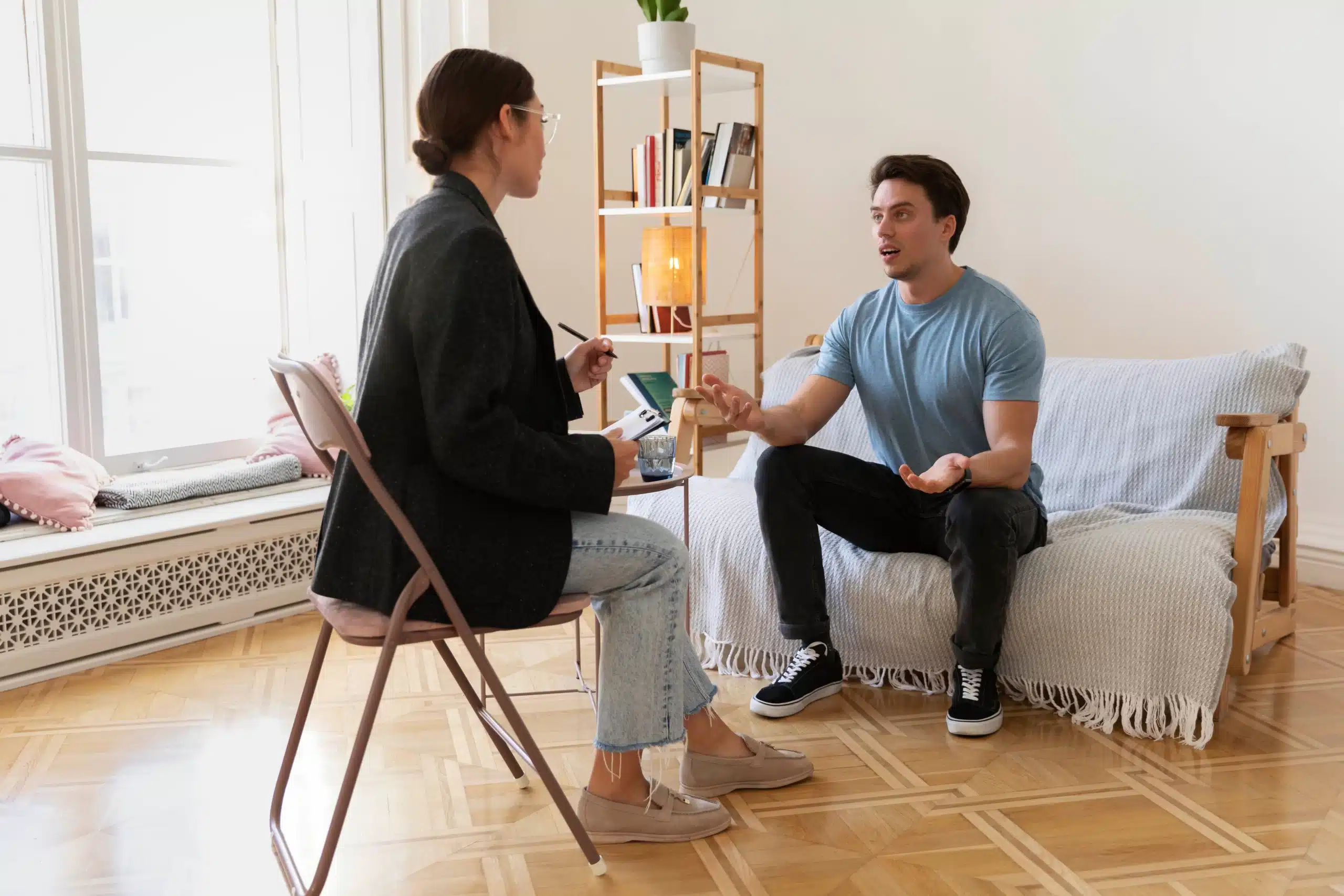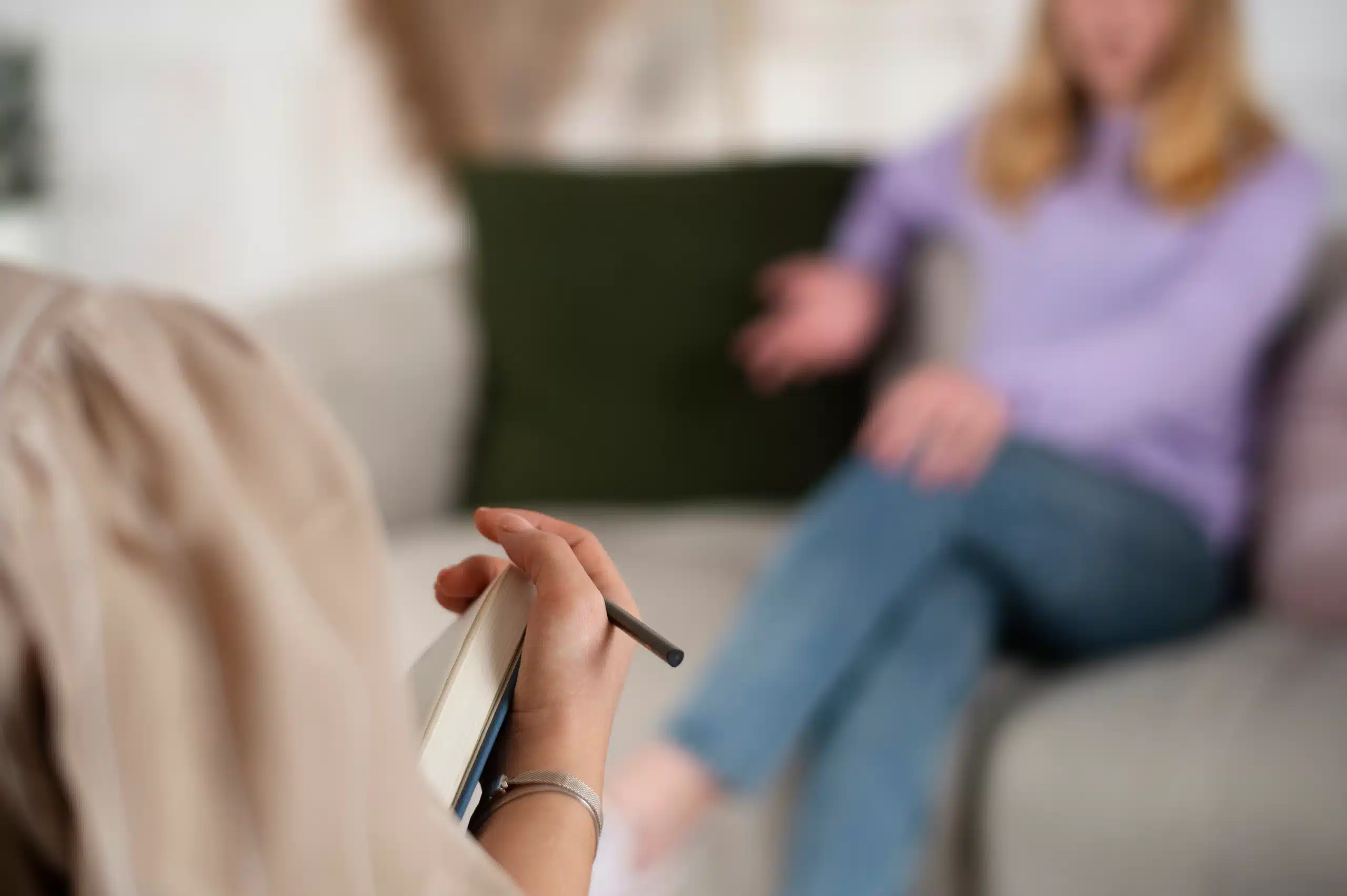Abstract
In the relentless current of contemporary life, anxiety has emerged as a pervasive and often debilitating challenge, affecting millions across the globe. From the relentless hum of social media and economic uncertainties to the overwhelming deluge of information, modern society presents a unique array of triggers that can amplify stress and erode inner calm. This whitepaper offers a comprehensive and compassionate guide for anyone navigating the complexities of anxiety, moving beyond superficial coping mechanisms to embrace a truly holistic approach. It meticulously explores common anxiety triggers endemic to the modern world and provides a multi-faceted framework for managing stress and cultivating inner peace. The document details effective therapeutic modalities (including Cognitive Behavioural Therapy and mindfulness-based practices), alongside crucial lifestyle adjustments (such as nutrition, sleep, and physical activity), and a repertoire of practical, immediate coping mechanisms. By empowering readers with knowledge, actionable strategies, and a path towards professional support, this whitepaper aims to illuminate a path towards finding sustainable calm and reclaiming well-being in the UK and beyond.
1. Introduction: The Unsettled Mind of the Modern Age
In an age of unprecedented connectivity and rapid advancement, it might seem counterintuitive that so many of us feel increasingly disconnected, overwhelmed, and fundamentally anxious. Yet, for millions, anxiety has become an unwelcome constant, a persistent undercurrent that erodes peace of mind, saps energy, and interferes with daily life. Whether it manifests as a nagging worry, a racing heart, or a full-blown panic attack, anxiety is the body’s natural alarm system gone awry, constantly perceiving threat where often there is none.
The modern world, with its relentless pace and unique pressures, presents a fertile ground for anxiety to flourish. From the curated perfection of social media feeds and the chilling uncertainty of economic landscapes to the ceaseless deluge of information and the blurred lines between work and life, our environment is replete with triggers that can overwhelm our nervous systems. While anxiety is a normal human emotion, its chronic and debilitating form demands a compassionate, comprehensive response.
This whitepaper serves as a guide for anyone experiencing the challenges of anxiety in the modern world. We will explore the common triggers unique to contemporary life and, crucially, offer a holistic approach to managing stress and finding sustainable calm. We will delve into effective therapeutic modalities, highlight essential lifestyle adjustments, and provide practical coping mechanisms for immediate relief. Our aim is to empower you with the knowledge and tools to navigate anxiety, cultivate resilience, and reclaim a sense of inner peace in a world that often seems anything but calm.
2. Anxiety in the Modern World: Understanding the Triggers
While anxiety is a timeless human experience, the contemporary landscape has introduced a unique set of triggers that can exacerbate stress and contribute to its pervasive nature.
2.1. The Digital Deluge: Social Media and Information Overload
- Social Media Comparison Culture: The curated, often unrealistic, portrayals of others’ lives on platforms like Instagram, Facebook, and LinkedIn can foster constant comparison, leading to feelings of inadequacy, FOMO (Fear Of Missing Out), and dissatisfaction with one’s own life.
- Constant Connectivity & “Always On” Culture: The expectation to be constantly available via email, messaging apps, and social media blurs the lines between work and personal life, preventing mental and emotional disengagement.
- Information Overload & “Doomscrolling”: The relentless stream of news, often negative or alarming (global crises, climate change, political instability), can overwhelm the nervous system. “Doomscrolling” – the tendency to consume excessive negative news – further amplifies anxiety.
- Notifications and Distraction: The constant ping of notifications fragments attention, reduces focus, and keeps the brain in a state of hyper-alertness, making it difficult to relax and be present.
2.2. Economic Uncertainty and Financial Strain
- Cost of Living Crisis (UK Specific): Rising inflation, energy bills, and housing costs create significant financial anxiety for many households, directly impacting mental well-being.
- Job Insecurity & Rapid Market Changes: Fast-evolving industries and economic volatility can lead to fears about job stability, career progression, and the future.
- Student Debt and Future Planning: For younger generations, the burden of student debt and the challenges of affording housing or starting a family can be a significant source of chronic anxiety.
2.3. Lifestyle and Environmental Factors
- Sedentary Lifestyles: Increased desk-bound work and reliance on technology can lead to less physical activity, which is crucial for regulating mood and reducing stress.
- Sleep Deprivation: The widespread problem of insufficient or poor-quality sleep (often exacerbated by digital habits) impairs the body’s ability to recover and regulate emotions, making one more susceptible to anxiety.
- Poor Nutrition: Diets high in processed foods, sugar, and unhealthy fats can negatively impact gut health and brain function, influencing mood and anxiety levels.
- Lack of Nature Connection: Decreased time spent outdoors and in natural environments can contribute to increased stress and reduced well-being.
- Urban Living Pressures: Noise pollution, overcrowding, fast pace, and social isolation in large cities can heighten stress and anxiety.
2.4. Performance Pressure and Self-Worth
- Perfectionism & High Expectations: Societal pressures to “succeed” in all areas of life (career, relationships, appearance, parenting) can lead to constant self-criticism and a fear of failure.
- Imposter Syndrome: The persistent feeling of being a “fraud” despite external achievements can fuel chronic anxiety and self-doubt.
- Comparison to “Ideal” Lives: The pervasive narrative of having a perfect life, body, or career (often perpetuated by social media) sets unrealistic benchmarks, leading to anxiety about not measuring up.
3. Therapeutic Modalities: Professional Pathways to Calm
While lifestyle adjustments are foundational, professional therapeutic support can provide deeper understanding, structured tools, and sustained guidance for managing and overcoming anxiety.
3.1. Cognitive Behavioural Therapy (CBT)
- Core Principle: CBT helps individuals identify and challenge unhelpful thinking patterns and behaviours that contribute to anxiety. It focuses on the interconnectedness of thoughts, feelings, and actions.
- How it Helps:
- Cognitive Restructuring: Helps to recognise and reframe distorted or irrational anxious thoughts (e.g., catastrophising, overgeneralisation, black-and-white thinking).
- Exposure Therapy: Gradually exposes individuals to feared situations or objects (in a safe, controlled manner) to reduce avoidance behaviours and diminish the anxiety response.
- Behavioural Experiments: Designing small, real-life experiments to test anxious predictions and gather evidence that challenges negative beliefs.
- Relaxation Techniques: Teaches practical skills like deep breathing and progressive muscle relaxation to manage physical symptoms of anxiety.
- Problem-Solving Skills: Equips individuals with structured approaches to tackling anxiety-provoking situations.
- Best For: Generalised Anxiety Disorder (GAD), Social Anxiety Disorder, Panic Disorder, Obsessive-Compulsive Disorder (OCD), Phobias. Highly evidence-based.
3.2. Mindfulness-Based Approaches (MBCT, MBSR)
- Core Principle: Focuses on cultivating present moment awareness, observing thoughts and feelings without judgment, and responding to experiences with greater wisdom and compassion.
- How it Helps:
- Non-Judgmental Observation: Teaches individuals to notice anxious thoughts, bodily sensations, and emotions without getting caught up in them or trying to suppress them.
- Reducing Rumination: By focusing on the present, mindfulness helps break the cycle of worrying about the past or future, which fuels anxiety.
- Increased Self-Awareness: Develops a deeper understanding of one’s own triggers and patterns of anxiety.
- Stress Reduction: Regular mindfulness practice can calm the nervous system, reducing physiological markers of stress.
- Best For: Reducing general anxiety, preventing relapse in depression (MBCT), managing chronic stress, cultivating inner calm. Can be integrated with other therapies.
3.3. Psychodynamic Therapy
- Core Principle: Explores how past experiences, unconscious conflicts, and relational patterns contribute to current anxiety symptoms. It looks beyond immediate triggers to deeper, unresolved issues.
- How it Helps:
- Understanding Root Causes: For anxiety that feels pervasive or without obvious external triggers, psychodynamic therapy can uncover underlying fears, unresolved trauma, or developmental issues.
- Processing Unconscious Conflict: Helps bring unconscious thoughts and feelings to awareness, allowing them to be understood and integrated, reducing their power to drive anxiety.
- Relational Patterns: Explores how early relationships might have shaped coping mechanisms or anxieties in current relationships.
- Lasting Change: By addressing the origins of anxiety, this approach can lead to more fundamental and sustainable shifts in personality and emotional functioning.
- Best For: Chronic, pervasive anxiety, anxiety linked to past trauma or relationship patterns, when other therapies have not provided lasting relief, or for those seeking deeper self-understanding.
3.4. Acceptance and Commitment Therapy (ACT)
- Core Principle: Encourages individuals to accept difficult thoughts and feelings (including anxiety) rather than fighting them, and to commit to actions aligned with their values, even in the presence of discomfort.
- How it Helps:
- Cognitive Defusion: Helps individuals distance themselves from anxious thoughts, seeing them as just thoughts, not truths.
- Mindful Acceptance: Teaches skills to observe anxiety symptoms without being overwhelmed or controlled by them.
- Values Clarification: Helps reconnect with what truly matters, providing direction and purpose, even when anxiety is present.
- Committed Action: Encourages taking steps towards a meaningful life, rather than being paralysed by anxiety.
- Best For: General anxiety, social anxiety, chronic worry, and for individuals struggling with avoidance behaviours.
4. Lifestyle Adjustments: Nurturing Your Nervous System
While therapy provides critical tools and insights, fundamental lifestyle adjustments are essential for nurturing the nervous system, reducing chronic stress, and building resilience against anxiety. These are not ‘extras’ but non-negotiable components of a holistic approach.
4.1. Prioritising Quality Sleep
- Consistent Sleep Schedule: Go to bed and wake up at roughly the same time each day, even on weekends, to regulate your body’s circadian rhythm.
- Optimise Your Sleep Environment: Ensure your bedroom is dark, quiet, cool, and comfortable.
- Avoid Stimulants Before Bed: Limit caffeine and alcohol, especially in the hours leading up to sleep.
- Wind-Down Routine: Create a relaxing bedtime routine (e.g., warm bath, reading, gentle stretching, meditation) to signal to your body that it’s time to rest.
- Digital Detox Before Bed: Avoid screens (phones, tablets, computers, TV) at least an hour before sleep, as blue light interferes with melatonin production.
4.2. Nourishing Nutrition
- Balanced Diet: Focus on whole, unprocessed foods: plenty of fruits, vegetables, lean proteins, and healthy fats.
- Omega-3 Fatty Acids: Found in oily fish (salmon, mackerel), flaxseeds, and walnuts, these are vital for brain health and can help reduce anxiety.
- Complex Carbohydrates: Foods like oats, brown rice, and wholemeal bread can boost serotonin levels, which have a calming effect.
- Limit Processed Foods, Sugar, and Caffeine: These can cause blood sugar spikes and crashes, exacerbate nervousness, and disrupt sleep.
- Hydration: Drink plenty of water throughout the day. Dehydration can affect mood and cognitive function.
- Gut Health: Emerging research highlights the gut-brain axis. Consider probiotics and fermented foods to support a healthy microbiome.
4.3. Regular Physical Activity
- Stress Release: Exercise is a powerful stress reliever, reducing stress hormones like cortisol and increasing mood-boosting endorphins.
- Choose What You Enjoy: Whether it’s walking, running, cycling, swimming, dancing, or team sports, consistency is key.
- Mindful Movement: Practices like yoga, Tai Chi, and Pilates combine physical activity with breathwork and mindfulness, enhancing their anxiety-reducing effects.
- Time in Nature: Exercising outdoors (e.g., walking in a park, hiking in the woods) combines the benefits of physical activity with exposure to natural environments, which has proven calming effects.
4.4. Mindful Media Consumption and Digital Boundaries
- Scheduled “News Diet”: Allocate specific times to check the news, and avoid constant consumption, especially before bed.
- Curate Your Social Media: Unfollow accounts that trigger comparison or negativity. Follow those that inspire, educate, or uplift.
- Notification Management: Turn off unnecessary notifications on your phone and computer to reduce constant distraction and mental fragmentation.
- Digital Detox Periods: Implement regular periods of complete digital disconnection (e.g., an hour before bed, one day a week) to allow your mind to rest and reset.
4.5. Cultivating Social Connection and Hobbies
- Quality Over Quantity: Prioritise genuine, supportive connections with friends and family. Social isolation exacerbates anxiety.
- Engage in Meaningful Activities: Dedicate time to hobbies, creative pursuits, or activities that bring you joy and a sense of accomplishment, separate from work or obligations.
- Volunteer: Helping others can shift focus from self-preoccupation, provide purpose, and foster positive social connections.
Implementing these lifestyle adjustments requires discipline and patience. Start small, integrate changes gradually, and be compassionate with yourself. They form a robust defence against anxiety and contribute significantly to overall well-being.
5. Practical Coping Mechanisms: Finding Immediate Calm
When anxiety strikes, having immediate, accessible coping mechanisms can help calm your nervous system, disrupt anxious thought patterns, and regain a sense of control.
5.1. Grounding Techniques (5-4-3-2-1 Method)
This technique helps bring your focus back to the present moment, away from anxious thoughts or overwhelming emotions.
- 5: Acknowledge 5 things you can see around you.
- 4: Acknowledge 4 things you can feel (e.g., the texture of your clothes, the temperature of the air, your feet on the ground).
- 3: Acknowledge 3 things you can hear (e.g., distant traffic, your own breathing, a fan).
- 2: Acknowledge 2 things you can smell (e.g., coffee, a candle, fresh air).
- 1: Acknowledge 1 thing you can taste (e.g., your breath, a mint, a sip of water).
5.2. Diaphragmatic Breathing (Belly Breathing)
Slow, deep breathing activates the parasympathetic nervous system, which calms the body.
- Inhale: Place one hand on your chest and the other on your belly. Inhale slowly and deeply through your nose, feeling your belly rise (chest should remain relatively still). Count to 4.
- Hold: Hold your breath for a count of 7.
- Exhale: Exhale slowly and completely through your mouth, making a gentle whooshing sound, as your belly falls. Count to 8.
- Repeat: Do this for 3-5 minutes, focusing only on your breath.
5.3. Progressive Muscle Relaxation (PMR)
This technique helps release physical tension often held during anxiety.
- Find a quiet place to sit or lie down.
- Start with your feet. Tense the muscles in your feet as tightly as you can for 5-10 seconds.
- Release the tension completely, noticing the feeling of relaxation.
- Slowly move up your body, tensing and releasing each muscle group (calves, thighs, glutes, abdomen, chest, arms, hands, neck, face).
- Notice the difference between tension and relaxation in each area.
5.4. Mental Distraction and Cognitive Shifting
- Engage Your Senses: Listen to music, watch a calming video, or engage in a sensory activity (e.g., holding an ice cube, splashing water on your face).
- Puzzle or Game: Engage in a mentally absorbing activity that requires focus, such as a crossword puzzle, Sudoku, or a simple phone game.
- Visualization: Close your eyes and imagine a calm, peaceful place (e.g., a quiet beach, a forest). Focus on the details – sights, sounds, smells, feelings.
5.5. Physical Release
- Movement: Go for a brisk walk, do some jumping jacks, or shake out your limbs. Physical movement can help discharge excess anxious energy.
- Crying: If you feel the urge, allow yourself to cry. It’s a natural release mechanism.
5.6. “Worry Time” (for Chronic Worriers)
- Designated Period: Allocate a specific 15-20 minute slot each day (e.g., 5 PM) for worrying.
- Containment: When a worry pops up outside this time, briefly acknowledge it, make a mental note to address it during “worry time,” and then redirect your attention back to the present task.
- Structured Approach: During “worry time,” you can write down your worries, problem-solve if possible, or just let them exist. Once the time is up, consciously move on.
These coping mechanisms are not long-term solutions but provide immediate relief, helping you manage acute moments of anxiety and prevent them from escalating. Practice them regularly so they become second nature when you need them most.
6. Conclusion: Cultivating Calm in a Hectic World
Anxiety, in its myriad forms, is an undeniable hallmark of our modern world, fuelled by pressures ranging from digital overload and economic uncertainty to the pervasive fear of not measuring up. However, confronting this challenge is not a journey into insurmountable despair, but rather an empowering path towards deeper self-understanding, resilience, and profound inner calm. This whitepaper has offered a comprehensive, holistic blueprint for navigating this complex landscape.
We have explored the unique contemporary triggers that exacerbate anxiety and, crucially, provided a multi-faceted framework for reclaiming well-being. From evidence-based therapeutic modalities like CBT, psychodynamic therapy, and ACT, which offer structured tools and deeper insights into the roots of distress, to the foundational importance of nurturing lifestyle adjustments (sleep, nutrition, exercise, and mindful digital use), and a practical arsenal of immediate coping mechanisms, the path to calm is illuminated.
For anyone in the UK experiencing the unsettling grip of anxiety, remember that you possess the capacity to influence your internal landscape, even amidst external chaos. By embracing a combination of professional support, dedicated self-care, and consistent practice of calming techniques, you can not only manage your stress but fundamentally transform your relationship with it. The journey towards finding lasting calm is a testament to your resilience and a vital investment in your overall well-being, enabling you to live a fuller, more present, and truly empowered life in the modern world.
7. References
- [1] American Psychiatric Association. (2013). Diagnostic and Statistical Manual of Mental Disorders (DSM-5). American Psychiatric Publishing.
- [2] World Health Organization (WHO). (2017). Depression and other common mental disorders: global health estimates. (Highlights prevalence of anxiety disorders globally).
- [3] Beck, A. T. (1976). Cognitive Therapy and the Emotional Disorders. International Universities Press. (Foundation of CBT).
- [4] Segal, Z. V., Williams, J. M. G., & Teasdale, J. D. (2018). Mindfulness-Based Cognitive Therapy for Depression: A New Approach to Preventing Relapse. Guilford Press. (For MBCT).
- [5] Hayes, S. C., Strosahl, K. D., & Wilson, K. G. (2012). Acceptance and Commitment Therapy: The Process and Practice of Mindful Change. Guilford Press. (For ACT).
- [6] Fonagy, P., & Target, M. (2003). Psychoanalytic Theories: Perspectives from Developmental Psychopathology. Elsevier Science. (Relevant for psychodynamic insights into anxiety).
- [7] Goleman, D. (1995). Emotional Intelligence: Why It Can Matter More Than IQ. Bantam Books. (Relevant for understanding emotional regulation).










